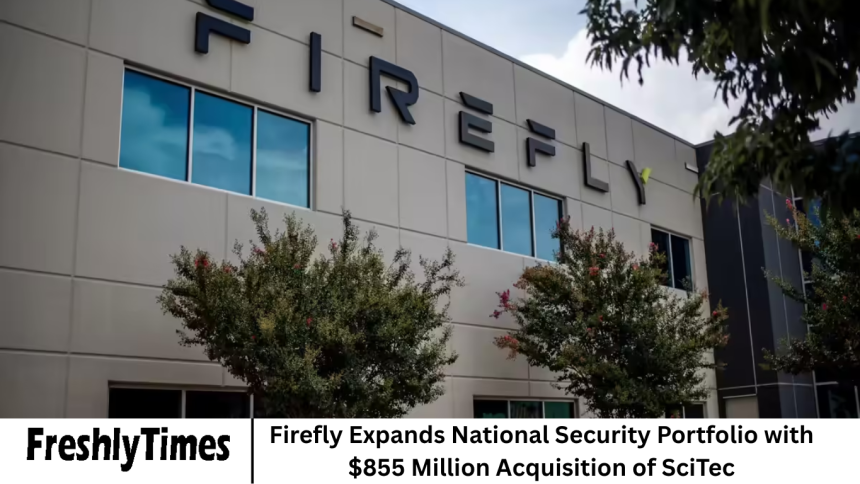In a strategic move that underscores the growing intersection between private aerospace innovation and national security, Firefly Aerospace has announced the acquisition of SciTec, a leading defense and intelligence technology firm, for an estimated $855 million.
- The Deal: A Bold Step into National Security Technology
- Who Is SciTec? A Quiet Force in National Security
- Firefly’s Vision: Integrating Hardware and Intelligence
- Strategic Importance: Strengthening the U.S. Defense Ecosystem
- Industry Context: A Growing Trend of Mergers and Acquisitions
- Technical Synergy: What the Partnership Brings
- Enhanced Space Situational Awareness (SSA)
- Mission Data Exploitation
- AI and Machine Learning Integration
- End-to-End Defense Solutions
- Government Contract Expansion
- Financial and Regulatory Outlook
- Market Reactions and Expert Commentary
- Future Outlook: Firefly’s Expanding Role
- Broader Implications: The Future of Private Defense Innovation
- Challenges Ahead
- Frequently Asked Question
- Conclusion
The deal marks one of the largest private-sector transactions in the national security technology domain this year and represents a major step in Firefly’s evolution from a launch services company to a comprehensive defense and space systems powerhouse.
This acquisition not only expands Firefly’s technical capabilities but also deepens its involvement with U.S. government clients such as the Department of Defense (DoD), NASA, and intelligence agencies.
More Read: French PM Quits After 27 Days, Deepening Political Chaos
The Deal: A Bold Step into National Security Technology
The $855 million acquisition is being hailed as a transformative milestone for Firefly Aerospace, a company traditionally known for its cost-efficient small and medium satellite launch vehicles. By acquiring SciTec, a firm renowned for its advanced data exploitation, space situational awareness.
and sensor technology, Firefly effectively broadens its operational landscape from launch hardware into national security-grade software and analytics. Industry analysts suggest that this move is part of Firefly’s broader strategy to diversify its offerings amid a competitive and volatile launch market.
While Firefly’s Alpha rocket and Blue Ghost lunar lander projects have drawn attention, the company’s leadership recognizes that long-term stability lies in expanding into adjacent sectors like defense technology and intelligence systems.
The acquisition was financed through a mix of equity and debt instruments, supported by Firefly’s existing investors and a new round of strategic funding. The transaction is expected to close in late 2025, pending regulatory approval from U.S. defense oversight agencies.
And the Committee on Foreign Investment in the United States (CFIUS).
Who Is SciTec? A Quiet Force in National Security
Founded in 2005, SciTec Inc. has operated largely under the radar, focusing on providing critical technology and analytical services to the U.S. defense and intelligence community. With headquarters in Princeton, New Jersey, and multiple offices across the U.S., SciTec employs over 600 scientists.
Its core expertise lies in data fusion, sensor development, and real-time data interpretation for national security applications. SciTec’s software solutions are integral to several high-profile government programs involving missile warning systems, space situational awareness (SSA).
And ISR (Intelligence, Surveillance, and Reconnaissance) capabilities. What makes SciTec valuable is its end-to-end data chain — from sensor design and collection to AI-driven analytics and visualization. This allows defense operators to make faster and more accurate decisions.
Whether it’s tracking satellite anomalies, identifying threats in low Earth orbit, or monitoring missile activity.
Firefly’s Vision: Integrating Hardware and Intelligence
By bringing SciTec under its umbrella, Firefly Aerospace aims to become a vertically integrated space and defense company capable of managing the full lifecycle of national security missions — from launch to data interpretation.
Firefly CEO Bill Weber described the acquisition as “a defining moment in Firefly’s mission to support America’s defense capabilities.” In a public statement, Weber emphasized that combining Firefly’s manufacturing, launch, and lunar delivery platforms with SciTec’s.
Advanced analytics will “deliver unmatched value to U.S. government partners and expand the nation’s resilience in space.” This integration strategy mirrors a broader trend in the aerospace sector: companies are no longer content to focus solely on hardware.
Instead, they are building ecosystems that combine launch capability, spacecraft production, AI analytics, and mission services — creating “end-to-end mission pipelines.”
The result is a more agile, data-driven approach to space operations — one that is increasingly vital as space becomes a contested and congested domain.
Strategic Importance: Strengthening the U.S. Defense Ecosystem
The timing of this acquisition is not accidental. With geopolitical tensions rising and space emerging as a new frontier of defense competition, the U.S. government is pushing for stronger collaboration between private industry and national security agencies.
The Pentagon’s Space Development Agency (SDA) and U.S. Space Force have both emphasized the need for rapid innovation in satellite technology, data processing, and threat detection. By merging with SciTec, Firefly positions itself as a key contributor to these efforts.
A company capable of supporting both tactical missions and strategic space resilience. Moreover, the deal aligns with recent U.S. defense initiatives aimed at fostering a “commercial-first” approach to military technology acquisition.
This means the government increasingly relies on private companies like Firefly, SpaceX, and Anduril to provide cutting-edge capabilities more efficiently than traditional defense contractors.
Industry Context: A Growing Trend of Mergers and Acquisitions
Firefly’s purchase of SciTec is part of a larger wave of mergers and acquisitions within the aerospace and defense technology sectors. Companies are consolidating to create vertically integrated ecosystems that can deliver complex, multi-domain solutions.
In recent years, similar moves have been made by:
- Anduril Industries, which acquired artificial intelligence firms to expand its autonomous defense capabilities.
- L3Harris Technologies, which merged with Aerojet Rocketdyne to bolster propulsion systems for military and space applications.
- Rocket Lab, which has expanded from launch services into satellite production and space-based intelligence gathering.
These consolidations are driven by a common theme: the recognition that data and intelligence are as important as rockets and satellites in modern defense operations. Firefly’s acquisition of SciTec places it firmly within this evolving ecosystem.
Technical Synergy: What the Partnership Brings
The combined capabilities of Firefly and SciTec could create powerful synergies across several domains:
Enhanced Space Situational Awareness (SSA)
Firefly can now integrate SciTec’s advanced algorithms into its spacecraft platforms, allowing real-time monitoring of orbital debris, satellite trajectories, and potential threats.
Mission Data Exploitation
SciTec’s software can process and analyze the immense data generated from Firefly’s missions — whether lunar landings, satellite deployments, or orbital testing — providing clients with actionable insights.
AI and Machine Learning Integration
The acquisition strengthens Firefly’s AI footprint, enabling predictive analytics for satellite health, defense tracking, and autonomous mission control systems.
End-to-End Defense Solutions
From launching reconnaissance satellites to interpreting defense imagery, Firefly and SciTec together can deliver a full mission chain, reducing dependency on external contractors.
Government Contract Expansion
SciTec’s deep ties with U.S. defense agencies give Firefly access to classified projects and new procurement pipelines previously beyond its reach.
Financial and Regulatory Outlook
The $855 million deal, while ambitious, is seen as financially viable due to Firefly’s increasing revenue streams from both commercial and government contracts. The company has been a key participant in NASA’s Commercial Lunar Payload Services (CLPS) program.
And recently secured contracts with the U.S. Space Force for responsive launch services.However, analysts note that Firefly’s entry into the classified defense domain will come with new oversight responsibilities.
The acquisition will undergo review by both the Defense Counterintelligence and Security Agency (DCSA) and CFIUS, ensuring that national security interests are preserved. If approved, the merger could set a precedent for other mid-sized aerospace firms seeking to expand into defense intelligence without compromising operational independence.
Market Reactions and Expert Commentary
The market response to Firefly’s announcement has been largely positive. Industry observers see this as a strategic pivot that could elevate Firefly’s valuation and market competitiveness.
John Plumb, a former U.S. Assistant Secretary of Defense for Space Policy, commented that “the Firefly-SciTec merger is exactly the kind of industry collaboration the Pentagon has been calling for — agile, data-centric, and mission-oriented.”
Meanwhile, Aerospace analyst Laura Cheng from Morgan Securities remarked that “Firefly is doing what smaller space companies must do to survive long term — integrate vertically and build sustainable revenue beyond launch contracts.”
However, others caution that merging two companies with different operational cultures — one hardware-oriented, the other software-focused — could pose integration challenges. Effective leadership, shared vision, and harmonized workflows will be crucial for long-term success.
Future Outlook: Firefly’s Expanding Role
With SciTec on board, Firefly is poised to compete not just with traditional launch providers like Rocket Lab or Relativity Space, but also with defense-tech hybrids like Anduril and Palantir.
The company plans to establish a “National Security Division”, focusing on:
- Space-based threat detection systems
- Intelligence and data analytics services
- Next-generation satellite and sensor integration
This division will leverage SciTec’s expertise while using Firefly’s manufacturing infrastructure to produce mission-ready hardware. The goal is to offer end-to-end national security solutions — from orbital deployment to data interpretation — under a single corporate framework.
Firefly also intends to maintain SciTec’s existing contracts and workforce, signaling that the acquisition is more about integration than absorption. SciTec’s brand will likely remain active, functioning as a subsidiary within Firefly Defense Systems.
Broader Implications: The Future of Private Defense Innovation
This acquisition exemplifies how the boundaries between commercial spaceflight and national defense are blurring. As space becomes a strategic frontier, companies that can operate effectively in both domains — like Firefly now can — are becoming invaluable assets to U.S. security infrastructure.
The U.S. government’s reliance on private firms is expected to deepen over the next decade, as agencies seek rapid innovation and cost efficiency. The Firefly-SciTec merger could serve as a model for similar partnerships, bridging aerospace manufacturing with data intelligence to create hybrid defense ecosystems.
Challenges Ahead
Despite the optimism, challenges remain. Integration risks include:
- Aligning cybersecurity and data handling standards across both companies.
- Managing classified information while maintaining commercial operations.
- Balancing rapid innovation with stringent government compliance requirements.
Furthermore, competition in the national security tech sector is fierce. Established giants like Lockheed Martin, Northrop Grumman, and Raytheon are investing heavily in AI-driven intelligence platforms, while newer entrants like Anduril are disrupting procurement models through software-first solutions.
Firefly’s success will depend on how well it can merge agility with accountability — a balance that has eluded many companies in the defense sector.
Frequently Asked Question
What is the significance of Firefly acquiring SciTec?
The acquisition allows Firefly to expand beyond rocket launches into the national security technology sector. SciTec’s expertise in data analytics, AI, and sensor technology complements Firefly’s aerospace hardware, creating a vertically integrated defense and space solutions provider.
How much is the acquisition worth?
The deal is valued at $855 million, making it one of the most substantial private-sector acquisitions in the national security technology industry in 2025.
Who is SciTec, and what does the company do?
SciTec is a U.S.-based defense technology firm specializing in data fusion, sensor analytics, and intelligence systems. It provides advanced software solutions to U.S. defense and intelligence agencies for applications such as missile detection, satellite monitoring, and threat analysis.
Why is this acquisition strategically important for Firefly?
It diversifies Firefly’s business portfolio, reduces its reliance on launch contracts, and enhances its value proposition to government clients. The move also strengthens Firefly’s ability to compete in the growing defense-tech market.
Will SciTec continue to operate independently?
Yes, SciTec is expected to remain a subsidiary of Firefly Aerospace under the new Firefly Defense Systems division, maintaining its existing contracts, workforce, and brand identity while integrating closely with Firefly’s engineering and mission teams.
What are the potential challenges of this merger?
Integration challenges may include aligning company cultures, ensuring cybersecurity compliance, and navigating complex regulatory frameworks related to classified defense work. Firefly must also balance rapid innovation with government accountability.
How will this acquisition affect the national security landscape?
The Firefly-SciTec merger enhances the private sector’s role in U.S. defense innovation, fostering faster, data-driven responses to threats in space and beyond. It reflects a broader shift toward commercial-government partnerships in maintaining national security and space dominance.
Conclusion
The $855 million acquisition of SciTec marks a turning point for Firefly Aerospace. What began as a small launch company has evolved into a formidable player in the national security and space intelligence arena.
This deal is more than a business transaction — it’s a signal of how rapidly the defense landscape is changing. As the lines between space exploration, data analytics, and military readiness continue to blur, Firefly’s bold move places it at the center of a new era of integrated defense innovation.














